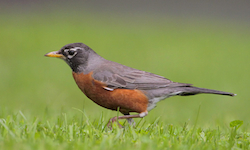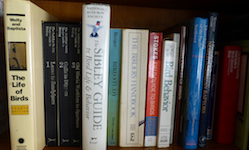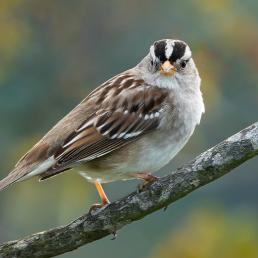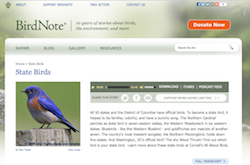

Join BirdNote tomorrow, November 30th!
Illustrator David Sibley and actor H. Jon Benjamin will face off in the bird illustration battle of the century during BirdNote's Year-end Celebration and Auction!
How do birds make such different sounds?
A lesson for middle or high school in two class periods
|  |  | ||
| Summary | Lesson Plan | Resources |
Summary
Looking for an interactive lesson to enhance your physics curriculum? After listening to BirdNote’s podcast on birdsongs and calls, students will use spectrograms as a visual tool to identify different species of birds by sound. Students will also study an animated model of a bird’s syrinx to understand how birds are able to perform their impressive acts of vocalization. This lesson covers learning standards in physics and life sciences.
Title: Calling All Birds
Duration: Two class periods
Setting: Indoors
Subject Areas: Living Environment, Physics
Grade Level: Middle School, High School
Next Generation Science Standards: MS-PS4-1, MS-PS4-2, HS-PS4-1, HS-PS4-5, HS-LS4-2
Lesson Objectives:
* Students will be able to (SWBAT) understand that the unique anatomy of a songbird’s syrinx allows it to perform impressive acts of vocalization.
* SWBAT identify birds by sound, using the spectrogram as a visual tool.
How BirdNote is used: to introduce birdsongs and calls.
Materials: BirdNote podcast on songs and calls, access to technology, 5 x 8" index cards, balloons, access to the outdoors (optional)
Lesson Plan
Motivate: Listen to a two-minute BirdNote podcast on songs and calls. Teachers can play the podcast on their computers or tablets or students can listen separately or in groups.
After they have listened, ask:
* What are some of the different reasons songbirds such as the Hermit Thrush use vocalization to communicate?
* What do you think is different about the anatomy of birds that allows them to create such a variety of vocalizations?
* Tell students that songbirds have evolved a specialized two-sided voice box called a syrinx that allows them to create unique sounds and gives them the ability to produce two unrelated pitches at once.
Teach: Together as a whole class or in small groups, access Cornell Lab of Ornithology’s website on How Birds Sing to observe and study an animated model of a bird’s syrinx. Here, students can observe the syrinx at work while listening to the songs of four different species – Northern Cardinal, canary, Brown Thrasher, and Wood Thrush. Click play at 1/4 speed to view the sound waves plotted out on spectrograms.
* Review with students how sound waves travel: Sound waves need to travel through a medium such as a solid, liquid, or gas. Sound waves move through each of these media by vibrating the molecules in matter. One way that researchers study songbird vocalization is by plotting the sound on a spectrogram.
* On each spectrogram, you see time from left to right on the x-axis and pitch from high to low on the y-axis. A third dimension indicates the amplitude of a particular frequency at a particular time and is represented by the intensity or color of each point on the image. Blue colors are fairly quiet and green and yellows are loud.
Do the Activity: Bird Song Hero interactive game
* Access Bird Song Hero interactive game and project on your Smart Board. Please note that this activity can be done in the school’s computer lab or in smaller groups at individual classroom computers if Smart Boards are not available.
* Separate class into small groups or teams that will compete against each other Jeopardy style. Directions are simple:
- Step 1: Play each song as many times as you want
- Step 2: Select the matching spectrogram
* Go through the Bird Song Hero tutorial together as a class. Next, compete in round 1 of Bird Song Hero. If time allows, students can compete in round 2, Bird Song Hero ULTIMATE!
Create:
* Organize students into small groups or pairs. Give each group a balloon and a 5 x 8" index card.
* One student blows up a balloon and proceeds to let air out slowly by pinching the open end of the balloon with the fingers, using the balloon bird as a model for a bird’s syrinx. Students should be creative with the sounds their balloon bird makes by pulling the end of balloon in different directions while letting the air out. Just like a bird’s syrinx!
* The rest of the students in the group should work on plotting out a spectrogram on their index card, based on the vocalization of their balloon bird.
* Completed spectrograms can be passed around to different groups so that they can try to recreate the balloon bird’s vocalization.
Extension: Take students on a bird walk to observe and identify birds singing and calling around your school.
Conservation project Ideas: Plant bird-friendly native plants around your school to attract your local native birds. For ideas on how to make your school bird friendly, please visit AudubonAdventures website.
Resources
BirdNote show Songs and Calls - They're not the Same
How Birds Sing Interactive Feature
Bird Song Hero Tutorial
Bird Song Hero Round 1
Bird Song Hero Round 2 ULTIMATE
Supplementary BirdNote podcasts:
Long Story in a Short Song
Song Sparrows Learn to Sing
Do you have a lesson plan to share? Check out the guidelines, then download the submission form. Thank you!

